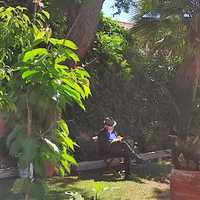
Katarzyna Nowak-McNeice
Katarzyna Nowak-McNeice is Associate Professor of English at the University of Wroclaw, Poland. She was Conex Research Fellow at the University Carlos III in Madrid, Spain. She obtained her doctoral degree from the University of Wroclaw in 2005. In 2007 she published a monograph titled Melancholic Travelers: Autonomy, Hybridity and the Maternal (Peter Lang); and in 2010 co-edited a collection Interiors: Interiority/Exteriority in Literary and Cultural Discourse (Cambridge Scholars Publishing). She has published papers on postcolonial literatures, as well as translations of essays and poetry (English into Polish). Her research interests include post-colonial literatures and theory, American literature, gender studies, and opera studies. Her recent publications include:
- “Joan Didion's California: Literary Representations of History, Melancholy and Transgression” in The Quint: An Interdisciplinary Quarterly from the North, vol. 7.1 (December 2014). 82-99. ISSN 1920-1028.
- “Representation of the Displacement of California’s Native American Population: Helen Hunt Jackson’s Ramona” in Cultures in Movement, ed. Martine Raibaud, Micéala Symington, Ionut Untea, David Waterman, Cambridge: Cambridge Scholars Publishing, 2015. 58-69.
- “Remembering the Loss, Constructing the Future: Time and Memory in Helen Hunt Jackson’s Ramona” in “Hours Like Bright Sweets in a Jar” – Time and Temporality in Literature and Culture, ed. Alicja Bemben, Cambridge: Cambridge Scholars Publishing, 2014. 69-80.
- “Joan Didion's California: Literary Representations of History, Melancholy and Transgression” in The Quint: An Interdisciplinary Quarterly from the North, vol. 7.1 (December 2014). 82-99. ISSN 1920-1028.
- “Representation of the Displacement of California’s Native American Population: Helen Hunt Jackson’s Ramona” in Cultures in Movement, ed. Martine Raibaud, Micéala Symington, Ionut Untea, David Waterman, Cambridge: Cambridge Scholars Publishing, 2015. 58-69.
- “Remembering the Loss, Constructing the Future: Time and Memory in Helen Hunt Jackson’s Ramona” in “Hours Like Bright Sweets in a Jar” – Time and Temporality in Literature and Culture, ed. Alicja Bemben, Cambridge: Cambridge Scholars Publishing, 2014. 69-80.
less
Related Authors
Joseph Carroll
University of Missouri - St. Louis
Josiah Heyman
University of Texas at El Paso (UTEP)
Matt Karp
Princeton University
Andrea Peto
Central European University
Joanna Pawlik
University of Sussex
Armando Marques-Guedes
UNL - New University of Lisbon
Nando Sigona
University of Birmingham
Francisco Vazquez-Garcia
Universidad de Cadiz
Timothy Morton
Rice University
חנוך בן-פזי Hanoch Ben-Pazi
Bar-Ilan University
InterestsView All (10)










Uploads
Books by Katarzyna Nowak-McNeice
of ableism, carnism, and sexism, and representing such a scenario in literary fiction as well as in film. The examples used to discuss the issue of exclusion on the basis of gender and species are Olga Tokarczuk’s Drive Your Plow Over the Bones of the Dead (2018) and Agnieszka Holland’s Spoor (2019), which serves as an example of a movie adaptation in which the idea of madness is related to political reality and
animal rights activism. What emerges from this contrast is a multifaceted representation of the fictional madness—strictly connected with animal rights activism. The main argument in this chapter is that different media allow for different levels of non-anthropocentric representations of nonhuman animals, with adaptation (fiction
to film) proposed as a possible scenario for liberation of representation mechanisms.
in critical theory, this essay explores the limits of fictional depictions of female
characters deemed ‘mad’ or ‘crazy’, who resist the oppressive systems of representation
and try – with varying levels of success– to function outside the parameters of heteronormative,
non- neurodiverse, patriarchal structures. The aim of my presentation is
to discuss the possibility of challenging and escaping the overlapping discriminatory
apparatuses of ableism, carnism, and sexism, and representing such a scenario in literary
fiction. I use the example of Olga Tokarczuk’s Drive Your Plow Over the Bones of
the Dead (2018). Laura Restrepo’s Delirium (2008), in turn, will serve as an example of
fiction in which the idea of madness is related to political reality and is imposed on the
character (in contrast to self- recognition) who never gains a clear voice. In both examples,
femininity and madness are interchangeable, albeit in different ways: one with an aim of
empowerment (Drive Your Plow), the other with an end of reducing the character to the
position of the silent other (Delirium). What emerges from this contrast is a multifaceted
representation of the fictional madness which can be used to either empower or demean,
and thus it shows the bipolar understanding of femininity in fiction and in culture.
ISBN: 113837041X
Papers by Katarzyna Nowak-McNeice
of ableism, carnism, and sexism, and representing such a scenario in literary fiction as well as in film. The examples used to discuss the issue of exclusion on the basis of gender and species are Olga Tokarczuk’s Drive Your Plow Over the Bones of the Dead (2018) and Agnieszka Holland’s Spoor (2019), which serves as an example of a movie adaptation in which the idea of madness is related to political reality and
animal rights activism. What emerges from this contrast is a multifaceted representation of the fictional madness—strictly connected with animal rights activism. The main argument in this chapter is that different media allow for different levels of non-anthropocentric representations of nonhuman animals, with adaptation (fiction
to film) proposed as a possible scenario for liberation of representation mechanisms.
in critical theory, this essay explores the limits of fictional depictions of female
characters deemed ‘mad’ or ‘crazy’, who resist the oppressive systems of representation
and try – with varying levels of success– to function outside the parameters of heteronormative,
non- neurodiverse, patriarchal structures. The aim of my presentation is
to discuss the possibility of challenging and escaping the overlapping discriminatory
apparatuses of ableism, carnism, and sexism, and representing such a scenario in literary
fiction. I use the example of Olga Tokarczuk’s Drive Your Plow Over the Bones of
the Dead (2018). Laura Restrepo’s Delirium (2008), in turn, will serve as an example of
fiction in which the idea of madness is related to political reality and is imposed on the
character (in contrast to self- recognition) who never gains a clear voice. In both examples,
femininity and madness are interchangeable, albeit in different ways: one with an aim of
empowerment (Drive Your Plow), the other with an end of reducing the character to the
position of the silent other (Delirium). What emerges from this contrast is a multifaceted
representation of the fictional madness which can be used to either empower or demean,
and thus it shows the bipolar understanding of femininity in fiction and in culture.
ISBN: 113837041X
ourselves, in my presentation I aim to explain the proliferation of terms and definitions, and
propose a reading of some recent literary texts (Blacker Than a Thousand Midnights by
Susan Straight, The Ministry of Utmost Happiness by Arundhati Roy, and Diary of a Bad Year
by John Coetzee) which provide an illustration of the current preoccupations with the
naming of the current moment: the Anthropocene (Paul J. Crutzen), the Capitalocene (Jason
Moore), or the Chthulucene (Donna Haraway). The main focus of my presentation is on the
connection between human and nonhuman animals: when we choose to conceptualize them
as intra-actions (after Karen Barad), in consequence we have to reconsider how we define
the human. This redefinition of the human is placed within the context of Jacques Derrida’s
carnophallogocentrism, and it opens up possibilities of imagining a post-anthropocentric
texts.
Attentive to the environment, the landscape, the flora and fauna in which human and nonhuman
life is immersed, Coetzee’s, Straight’s and Roy’s novels portray animal figures that
become a reminder of the shared vulnerability between human and nonhuman animal. The
animal figures point to the limits of expression (of speech and narration), and they become
a call for the recognition of other modes of being. Taking inspiration from Jacques Derrida
and Cary Wolfe, I focus on the ambivalent middle ground between the human and the
nonhuman where the limits of vulnerability and belonging lie.